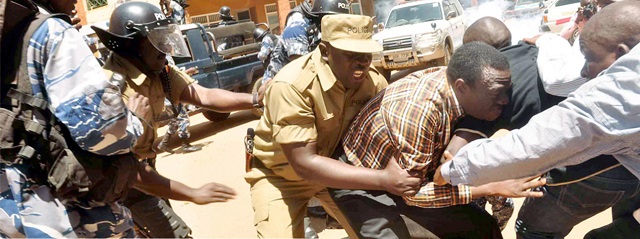
When Ochola who marked his first year as IGP in March this year replaced Kayihura, he immediately issued 12 directives to heads of different police units including regional, district and division police commanders for immediate implementation.
Ochola’s guidelines rotated around firearms management, discipline, crime, dress code and observance of human rights. In his second month, he closed the notorious Nalufenya Police facility on the eastern banks of River Nile in Jinja District.
Nalufenya had been described by human rights bodies, opposition politicians and former inmates as “hell on earth,” after several suspects detained there complained of torture.
Jamilu Mukulu, the leader of the ultra-Islamic Allied Democratic Forces, one of the most high profile detainees in custody, described Nalufenya as a “Slaughterhouse and pigsty.” He told a Jinja court that he had been forced to consume stuff prohibited by his faith—pork and alcohol. He was eventually transferred to Luzira Prison in Kampala.
But Michael Kabaziguruka (FDC, Nakawa Division) who also spent four months in detention facilities including Nalufenya after being accused of treason, terrorism and the alleged planning to overthrow President Museveni’s government told The Independent on July 17 that Ochola’s recent memo is cosmetic— something merely done to show the public that police is law-abiding.
“Once in a while we see overzealousness from the junior officers but they are generally compelled to obey orders of their senior colleagues,” Kabaziguruka said, “As long as the Police are still used as a political tool, the police will always commit torture.”
Kabaziguruka’s colleague in Parliament, Muhammad Muwanga Kivumbi, (DP, Butambala County) who also doubles as the Shadow Minister for Internal Affairs told The Independent recently that if Ugandans think Ochola’s letter reflects a new dawn in Uganda, they are wrong.
“Don’t tell anyone that it is now Uhuru,” he said.
“The directive is just a joke, it will not be enforceable and it is just a PR stunt,” he said, “That is going to the core of what has served the NRM regime; it is existential to the regime.” “This police serves the interests of a `deeper state’,” he says, “It is a cadre Police.”
Torture still rampant
Torture remains the most reported human rights abuse in Uganda.
In the UHRC’s report of 2018, for instance, of the 3,008 complaints that were recorded by the commission, 1,377 were torture victim cases. Another report from the African Centre for Treatment and Rehabilitation of Torture Victims (ACTV), a Kampala-based NGO, indicated that in a period between 2015 and 2018 they received 4,528 torture survivors of whom 3,293 were male and 1,235 female.
In 2018, the Press Index Report published by the Human Rights Network-Uganda also documented 163 cases of violations and abuses, compared to 113 cases recorded in 2017. It reported that, for the tenth consecutive year, Police was the leading offender of media rights (accounting for 53% of all cases reported during the year), followed by the army (17%).
Samuel Nsubuga, the Chief Executive Officer at ACTV says the organisation registers more than 1,000 cases of torture every year. To further show the scale of the problem, Nsubuga adds that over a three year period starting 2015, more than 4,500 torture victims, the majority of whom are men had been rehabilitated and counseled.
Meddie Kaggwa, the chairperson of the Uganda Human Rights Commission says incidents of torture and degrading treatment or punishments are still prevalent in the country.
President Yoweri Museveni has twice written a memo to his security forces guiding them on how to handle rioters, terrorists and looters. In one particular memo he wrote in October last year, following the brutal arrest of one, Yusuf Kawooya, a member of the Democratic Party’s youth wing, Museveni said brutalising of suspects is unnecessary, unfair and it gives Uganda a bad image.
Museveni’s 23 October, 2018 letter titled, “Guidelines on managing rioters, terrorists, criminals and looters and methods of arresting and handling suspects” was addressed to the Chief of Defence Forces, the Inspector General of Police and other heads of Uganda’s security organs.
Even Bart Katureebe, the Chief Justice has in the past shown concern about torture. At the commemoration of the 70th anniversary of the Universal Declaration of Human Rights last December, Katureebe noted that methods of pepper spraying suspects and kicking and beating them with gun butts violates suspects’ rights.
One step forward, two steps back
Still, Sewanyana told The Independent that human rights advocates will continue “watching the space” especially as the country moves into the 2021 election campaign period. Human rights activists say the trend has always been that as the general election draws closer, the more heightened cases of human rights violations tend to get.
Indeed, just a day before Ochola issued his memo, President Yoweri Museveni appointed more high ranking UPDF officers to head several police departments. The president picked Brig. Jack Bakashumba as the Police’s Chief of Joint Staff. He picked Brig. Godfrey Golooba to head the Directorate of Human Resource and Training while Col. Jese Kamunanwire was brought in to be the Director of Human Resource Administration. Meanwhile, Col. Chris Serunjogi Ddamulira took over the reins at the Crime Intelligence Directorate.
This development left Muwanga Kivumbi wondering what message President Museveni is trying to send by appointing four army officers to head key police departments, including the Directorate of Crime Intelligence.
“I have a feeling that IGP Ochola means well but it is the environment in which he operates that does not make his work easy,” Kivumbi told The Independent.
 The Independent Uganda: You get the Truth we Pay the Price
The Independent Uganda: You get the Truth we Pay the Price


